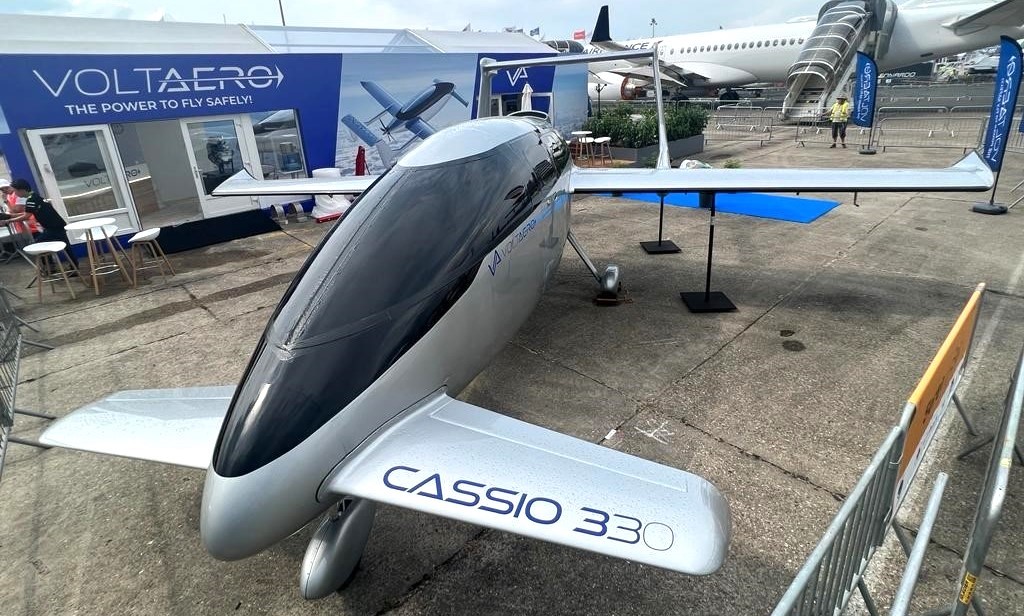Leeham News and Analysis
There's more to real news than a news release.
Kawasaki joins VoltAero to present a sensible hybrid aircraft
June 18, 2023, © Leeham News at Paris Air Show: VoltAero showed its Cassio 330 electric-hybrid test aircraft today at the Pairs Air Show, as it announced Kawasaki as the partner in realizing its rather different hybrid propulsion system.
We have analyzed hybrid aircraft concepts for eight years and have not found any that would live up to the claims of better fuel economy and lower emissions compared to the aircraft they shall replace. The root of the problem lies in batteries that weigh too much for the job.
The VoltAero Cassio family takes a different approach. It uses a small battery to produce a hybrid that utilizes the advantages of electric propulsion around the airport and the thermal engine for the rest of the flight. The strategy creates a sensible aircraft with operational advantages.
Our readers know our opinion about electric hybrids; they work for cars (because of the stoplights) but not for aircraft (as there are no stoplights in the sky). We have eight years of hybrid project analysis behind this opinion, where we had yet to find a hybrid aircraft concept that could bring tangible benefits to an aircraft (be it serial or parallel).
The Cassio family from VoltAero changes this, as we wrote here. The key is a design with a small battery, 42kWh (which is about five to 10 times less than other hybrids), that it only uses during takeoff and landing, where the 180kW electric motor driving the pusher propeller brings noise and pollution benefits. During the rest of the flight, a thermal engine drives the propeller.
The Cassio news today was threefold;
- Kawasaki Motors (the motorcycle division) will do the thermal engine for the Cassio family.
- The engines will start as gasoline engines that also can run on SAF. But then it will be offered in a hydrogen version, which is big news. Kawasaki will use the newly formed Hydrogen for piston engines R&D cooperation with Toyota, Honda, Suzuki, and Yamaha to develop the H2 version of a dedicated Kawasaki aero piston engine.
- The aircraft in Figure 1 is the flight test prototype of the Cassio 330 aircraft. The fuselage with engine installations and landing gear is the flight test parts. The wings and empennage are mockups. The final parts are in construction and will be fitted to the prototype in the coming months.
The Cassio 330 prototype shall make its maiden flight in late 2023. The aircraft will be used to validate the overall airframe configuration and aerodynamics. It will be powered by a four-cylinder Kawasaki Motors thermal engine derived from the Japanese company’s motorcycle engines.
The prototype will be followed by the No. 2 Cassio 330 prototype in the second quarter of 2024. It will be used for the airworthiness certification program and will be equipped with VoltAero’s final hybrid propulsion unit – composed of the four-cylinder Kawasaki Motors thermal engine (with a peak power rating of 165 kW) and a Safran electric motor of 180 kW peak power rating.
VoltAero has selected AKIRA Technologies for the integration and validation of Cassio’s hybrid propulsion unit. This company – which is specialized in the design and production of energy conversion systems and test benches – will design the Cassio hybrid propulsion unit’s gearbox. It will also do the mechanical integration and ground testing, as well as test/adaptation of the Kawasaki thermal engine and Safran electric motor.
The no. 2 Cassio 330 prototype will have a new avionics suite from Avidyne, adapted for single pilot operation. Avidyne will tailor the avionics to power manage Cassio’s hybrid propulsion unit.
The Cassio 330 has a four/five-seat interior configuration. The next aircraft in the family is the six-seat Cassio 480 with a combined electric-hybrid propulsion power of 480 kilowatts. Finally, the Cassio 600 is a 10/12-seater with an electric-hybrid propulsion power of 600 kilowatts. It will use a new six six-cylinder engine from Kawasaki.



This thing is sort of a short-duration, take-off only hybrid.
Typically, a general aviation ICE is designed to deliver 100% rated power at take-off, 75-85% during climb, and 55-65% during cruise.
With this power schedule, a decent piston ICE should be good for a 2000-hour TBO.
So where is the hybrid arrangement helping here?
Is Kawasaki planning to run their motorcycle ICE full blast, 100% power all the time, at cruise?
This will be tough for engine TBO.
Sounds like the LeeHam eight-year clock should still be ticking away.
Surely a piston ICE manufacturer of many decades can manage equivalent or better TBO than existing when the operating conditions required of the ICE are simpified/reduced compared to existing. Ground based piston ICE with fairly constant operating conditions can be very reliable.
NinjaH2R
max power – 240 kW / 14,000 rpm
max torque – 165 N•m / 12,500 rpm (216 kW)
Curb weight of the bike is 216 kg
Amazing
You often see problems when converting automobile engines to aircraft use as you run long time at max continuous. Cars or Motorcycles normally do not do that, so Kawasaki better do a good job. The traditional problem areas are cylinder heads and exhaust turbine and housing with lubrication and cooling of the turbo’s. For engines driving props it is the reduction gears and prop thrust bearing that see problems. Just check the early Thielert Centurion diesel aircraft engines before they had to solve its problems.
Highly sceptical over these electrical taxis competing with Tesla’s, neglectable time saving door to door & using 8x as much (happily assumed green) electricity. And 40x more noisy, 10x more expensive.
This Cassio concept seems to contain more of what an aircraft is useful for, speed & range, quick recharge/high utility. That’s something.
keejse:
We agree!
Only save time if they land in the streets, phew and even then the cost would be huge.